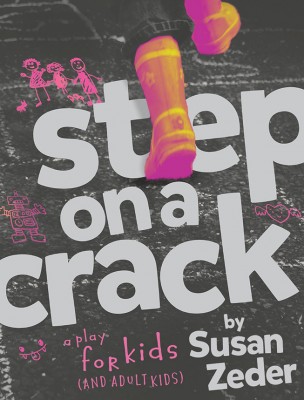When most people think of children’s theatre, they usually picture stories inundated with magic, new lands, mystical creatures, and important lessons all being performed in intimate venues. In many cases, all these things can be true. However, children’s theatre can be just as diverse and significant as theatre for more adult audiences. This fall, Colorado State University Theatre will be on a mission to prove this.
Under the direction of Laura Jones, theatre students, and kids in the Fort Collins community, present Step on a Crack by Suzan Zeder. The story follows Ellie Murphy who grows up the child of a single dad. But, when her father remarries, Ellie seeks an escape from reality by adventuring with her imaginary friends, Lana and Frizbee, learning some important lessons along the way. It is not new for CSU to be taking on children’s theatre, and this play has long awaited its opportunity to fill the slot. “I first encountered Suzan Zeder’s Step on a Crack in graduate school at the University of Denver,” says Jones, whose teaching assistantship was in children’s theatre. She was given the green light by her professor, Dr. Annabelle Clark, to direct the show on a shoe-string budget, which first introduced a piece featuring contemporary themes to the DU campus. She explains that it is time to put it on the CSU stage saying, “I can finally do the play the justice it deserves by bringing 30 years of post-doctoral experience to bear.”
Step on a Crack will be a marvelous addition to CSU’s children’s theatre repertoire as it is written by one of the leading playwrights for youth and family audiences in the United States. Suzan Zeder is known for expanding the subject matter of children’s theatre to include themes like divorce, stepparents, and deafness. Zeder was first introduced to writing for family audiences in graduate school at Southern Methodist University where she was asked by a professor to do an adaptation of the folktale entitled Wiley and the Hairy Man. As a young writer still trying to find her voice, Zeder discovered immense joy in being able to let her imagination run wild in this storytelling world where anything was possible. Her adaptation is still her most produced play and opened the door to the evolution of mature children’s theatre. In an industry flooded with fairytales where good fights evil and social norms are upheld, Zeder was one of the first to portray child characters as smart, strong, and complex as they work through real-life challenges.
 The audition process has been Jones’ favorite part of putting this show together so far. Step on a Crack is built around the importance of imagination which made it a key element in finding the perfect actors. Jones describes the auditions as a time for the actors to just have fun, recalling that “actors playing Ellie’s imaginary friends were in the small acting lab with boxes of assorted props and asked to engage in unscripted ‘play’.” The design meetings have also given Jones immense inspiration. The design team, led by Lighting, Sound, and Projections Design Professor Price Johnston, have worked hard to keep the play in its original 1970s setting. For Jones and the rest of the team, it has been a blast to work with neon, shag carpeting, a curtain made out of bottle caps, and plenty of bell bottom jeans.
The audition process has been Jones’ favorite part of putting this show together so far. Step on a Crack is built around the importance of imagination which made it a key element in finding the perfect actors. Jones describes the auditions as a time for the actors to just have fun, recalling that “actors playing Ellie’s imaginary friends were in the small acting lab with boxes of assorted props and asked to engage in unscripted ‘play’.” The design meetings have also given Jones immense inspiration. The design team, led by Lighting, Sound, and Projections Design Professor Price Johnston, have worked hard to keep the play in its original 1970s setting. For Jones and the rest of the team, it has been a blast to work with neon, shag carpeting, a curtain made out of bottle caps, and plenty of bell bottom jeans.
So why is it so important that children’s theatre is included in the CSU season on a regular basis? For one, children are the most challenging of all audiences. They let you know when they are not amused by fidgeting and will always be honest in their reactions. This brings a fresh challenge to the actors who must become fully committed to their jobs onstage. Second, children in our community and beyond are our future and we owe it to them to continue including them in our art so that it may be appreciated for many years to come. Jones put it best by saying, “If you can engage children at an early age, they are far more likely to support the arts as adults.” Lastly, children’s theatre is relatable – not just for kids, but also for adults. Take one of the major themes in Step on a Crack – single parents and mixed families. About fifty percent of all children in the United States under the age of thirteen are raised by one biological parent and that parent’s partner, making this piece immensely relatable.
Perhaps it is Zeder herself who puts it best. “I write because I cannot fly… but words can. And where they land, worlds appear and characters move and breathe and audiences come together in the alchemy of the moment.”
Don’t miss out on your opportunity to be part of this phenomenal performance!
~ by Lauren Scott, CSU theatre major.
Dates
Nightly at 7:30 p.m.: Oct. 9, 10, 16, 17, 23, 24
Matinees at 2 p.m.: Oct. 10, 11, 17, 18, 24, 25


